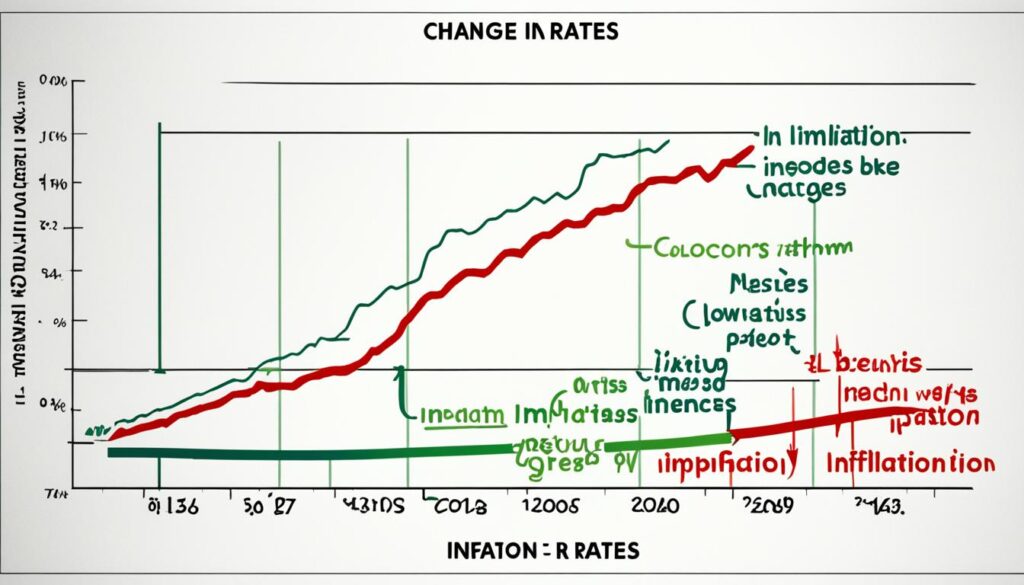In June 2024, the inflation rate measured by the Consumer Price Index (CPI) hit a significant threshold of 3.0%, marking a notable shift from its peak of 9.1% in mid-2022. This staggering rise in inflation rates has profound economic implications, underscoring the urgency for consumers, businesses, and policymakers to grasp its nuances. While the Federal Reserve targets a modest 2% inflation rate over the long run, the current trends raise critical questions about purchasing power, investment strategies, and overall economic stability.
Rising inflation rates can destabilize an economy, prompting a ripple effect that influences not just consumer behavior but also business strategies and investment decisions. As inflation impacts living costs—including essential goods and services—it becomes vital to analyze its root causes, distinguish between different types of inflation, and understand who bears the brunt of its effects. With inflation trends on the rise, navigating this complex landscape is more crucial than ever for maintaining economic equilibrium. In addition to domestic factors, the impact of globalization on local economies also plays a significant role in shaping inflation rates. The interconnectedness of global markets can lead to the transmission of inflation and monetary policies across borders, affecting not just the prices of imported goods and raw materials but also exchange rates and interest rates. Understanding and adapting to these dynamics is essential for businesses and policymakers alike in order to mitigate the broader impact of inflation on the economy. adapts to the changing landscape of inflation and its global implications.
Key Takeaways
- Inflation rate in the U.S. has surged by 20.8% since February 2020.
- The Federal Reserve aims for a long-term inflation target of 2%.
- Rising inflation impacts purchasing power, affecting low-income consumers most severely.
- Two main types of inflation—demand-pull and cost-push—explain price increases.
- The current inflation landscape influences investment strategies and business operations.
Understanding Inflation: A Broad Overview
Inflation represents a lasting increase in the price level of goods and services over time, significantly influencing consumers’ purchasing power. When examining an inflation overview, one can see its various measurements, notably through the Consumer Price Index (CPI) and the Personal Consumption Expenditures (PCE) price index. These indexes track how prices fluctuate and offer insights into the economic landscape.
In the United States, inflation surged to an alarming rate of 9.1 percent in June 2022, marking the highest level since February 1982. Such high inflation rates come with inflation consequences, notably increasing the cost of living and affecting overall economic performance. Conversely, an annual inflation rate around two percent is viewed favorably; it suggests economic stability and gradual growth.
Over the decades, historical comparisons highlight the severity of past inflation periods. For example, in 1947, inflation skyrocketed to 20 percent, while the peak of the “Great Inflation” in 1980 reached 14.8 percent. These instances underline the volatility and potential impact on consumer sentiment during inflationary periods.
One tangible example of inflation can be seen in the price of everyday items. A cup of coffee that cost just 25 cents in 1970 skyrocketed to $1.59 by 2019. Such statistics reflect the broader economic analysis of inflation’s effects on purchasing power and consumer behavior.
As inflation trends evolve, adapting to these changes becomes crucial. Companies often respond by raising prices to meet rising costs while striving to maintain customer demand. They may implement five key strategies during inflationary pressures: Adjust, Develop, Accelerate, Plan, and Track. These steps help businesses navigate challenging economic landscapes.

| Year | Inflation Rate (%) | Average Coffee Price ($) |
|---|---|---|
| 1970 | 5.84 | 0.25 |
| 1980 | 14.8 | 0.90 |
| 2022 | 9.1 | N/A |
| 2019 | 1.81 | 1.59 |
What Causes Inflation?
Understanding the causes of inflation requires an examination of various factors that significantly influence price increases. Two primary types of inflation drive these changes: demand-pull and cost-push inflation. Demand-pull inflation arises when consumer demand outstrips available supply, which creates upward pressure on prices. This situation often occurs during economic recoveries or periods of increased spending, where people release pent-up demand for goods and services.
On the other hand, cost-push inflation occurs when rising production costs compel businesses to raise prices in order to maintain profit margins. This type of inflation can stem from various sources, including increased costs of raw materials and labor. One of the most critical contributors in recent history has been oil price shocks, accounting for over 38% of global inflation variation over the past five decades. Events like geopolitical tensions or disruptions in supply chains can exacerbate these cost increases.
The economic implications of these inflation rates are immense, influencing everything from consumer behavior to monetary policy. For instance, oil prices impacted inflation by causing a 0.35 percentage point increase within one year after a 10% price shock, underscoring how interconnected these factors can be. Global demand shocks contributed about 28% to overall inflation variations, particularly evident during global recessions, further illuminating the complex dynamics at play.
Several external elements also contribute to inflationary trends. For example:
- The COVID-19 pandemic shifted consumer spending from services to goods, drastically affecting inflation movements.
- A surge in housing demand led to significant increases in housing prices.
- Production shortages in essential sectors, such as the auto industry, highlighted vulnerabilities in supply chains, contributing further to rising prices.
As businesses encounter these pressures, the aggregate effects on the economy manifest in various ways, impacting purchasing power, investment strategies, and overall stability.

| Type of Inflation | Definition | Key Contributors |
|---|---|---|
| Demand-Pull | Occurs when demand exceeds supply, leading to rising prices | Increased consumer spending, economic recovery |
| Cost-Push | Happens when rising costs compel businesses to increase prices | Higher raw material costs, labor expenses, oil price shocks |
As inflation rates shift, understanding the causes of inflation remains crucial for navigating potential economic challenges and seizing opportunities as they arise.
Demand-Pull vs. Cost-Push Inflation
Inflation manifests in two primary forms: demand-pull inflation and cost-push inflation. Understanding these concepts helps clarify the inflation impact on the economy and consumers.
Demand-pull inflation arises when consumer demand outstrips supply, typically occurring during periods of economic growth. When employment rates rise and people possess greater disposable income, demand for goods and services increases. The resurgence of economic activity post-COVID-19 lockdowns in 2020 illustrated this phenomenon. As businesses reopened, demand surged, significantly contributing to rising prices across multiple sectors.

Conversely, cost-push inflation results from an increase in the costs of production that manufacturers pass on to consumers. This type of inflation can be triggered by various factors, including natural disasters that disrupt supply chains or significant increases in commodity prices like oil. Events during the pandemic saw widespread disruptions, causing input costs to rise. Employers pressured to offer higher wages, due to rising consumer prices, found themselves contributing to cost-push inflation as these expenses were passed along to shoppers.
Both demand-pull and cost-push inflation underscore different aspects of economic challenges, illustrating the complex interplay between consumer behavior and supply-side factors. The annual inflation rate targeted by the Federal Reserve at around two percent aims to strike a balance among these contributing factors, promoting stable economic growth while avoiding runaway inflation. Understanding the nuances of these inflation types enhances awareness regarding economic conditions and potential strategies for consumers and businesses alike.
Inflation and Purchasing Power
Inflation significantly impacts purchasing power, affecting how much consumers can buy with their income. As inflation rises, the cost of goods and services increases, leading to a noticeable decrease in real purchasing power. Consumers are less able to afford their usual purchases, which creates wider economic implications.
In the United States, inflation reached a staggering 9.1% in 2022, a peak not seen in 40 years. This rise has led many consumers to rethink their spending habits. Reports indicate that over 50% of U.S. consumers have opted to shop less due to inflation effects, a clear indication of the strain on household budgets.
The Consumer Price Index (CPI) serves as a crucial metric for measuring inflation. It monitors price changes across a selected basket of goods and services, illustrating how inflation erodes purchasing power over time. For instance, food prices surged by 8.8%, while energy inflation skyrocketed by 32% in March. These skyrocketing costs lead consumers to prioritize essential items over discretionary expenditures.
The economic implications of this purchasing power erosion are profound. Lower-income households, which allocate around 77% of their budgets to necessities, feel these inflation effects more acutely. With food and energy costs sharply increasing, these families face tough choices regarding their spending and saving habits.
As inflation forecasts remain unclear, the potential for sustained high prices raises concerns about future financial stability for many households. The uncertainty regarding future inflation rates plays a crucial role in shaping consumer confidence and spending patterns.

Inflation’s Impact on Lower-Income Consumers
Lower-income consumers face distinct challenges stemming from the inflation impact, primarily because they allocate a greater share of their limited resources to essential goods. According to recent studies, 66% of lower-income Americans reported financial strain due to rising prices, demonstrating how severe the economic implications can be for this demographic.

The situation is particularly concerning when looking at the broader financial landscape. Around 55% of Americans reported experiencing some financial hardship due to inflation. Among lower-income consumers, this figure soars, with three-quarters indicating they have felt the effects of increasing prices acutely. The stark contrast becomes even more evident when examining severe hardship, where 28% of lower-income individuals reported facing significant difficulties, compared to only 13% of middle-income and 6% of upper-income groups.
To shed light on the severity of these challenges, consider the following statistics:
| Income Level | Percentage Experiencing Financial Hardship | Percentage Experiencing Severe Hardship |
|---|---|---|
| Lower-Income | 75% | 28% |
| Middle-Income | 56% | 13% |
| Upper-Income | ?? | 6% |
This disparity illustrates the burdens placed on lower-income consumers, who lack the financial cushions that wealthier households possess, such as investments in stocks or real estate. As inflation rises, the economic implications become pronounced, pushing these individuals deeper into financial distress. The data indicates a troubling trend, reflecting the ongoing challenges faced by those with limited resources amidst fluctuating prices.
Insight: The Economic Implications of Rising Inflation Rates
Rising inflation presents significant challenges and opportunities for businesses and investors alike. Understanding the economic implications of inflation effects can help stakeholders navigate these turbulent waters more effectively.
Effects on Businesses
According to the U.S. Chamber of Commerce, 54% of small business owners cite inflation as their top concern. This pressure encourages companies to raise prices for goods and services in order to maintain healthy profit margins. Higher product prices may reduce customer demand, complicating sales forecasts and cash flow management. Businesses often face increased operational costs, making adaptability crucial.
Despite the challenges, high inflation can present unique opportunities. Some sectors, such as healthcare, food, and transportation, remain relatively stable during inflationary periods. This stability allows nimble startups to adapt, addressing unmet market needs and creating new sales avenues. Moreover, businesses may find that funding from banks or private investors becomes easier to secure as these entities seek higher returns.
Impact on Investment Strategies
As investors grapple with inflation, their investment strategies often shift to seek safer assets. Real estate, energy commodities, and value stocks generally outperform during inflationary periods. In contrast, bonds and high-cost growth stocks may struggle to keep pace. The expectation of ongoing inflation can prompt a wage-price spiral, complicating investment decisions.
Overall, rising inflation not only affects the operational landscape for businesses but also reshapes how investors approach capital allocation. Both groups must stay agile and ready to revise strategies to maintain competitiveness and ensure sustainability amidst fluctuating economic conditions.

| Factor | Effect on Businesses | Effect on Investment Strategies |
|---|---|---|
| Price Increases | Higher operational costs; potential reduction in consumer demand | Shift toward safer investments like real estate |
| Funding Opportunities | Increased access to funding; investors seeking higher returns | Greater interest in sectors stable during inflation |
| Market Adaptability | Nimble startups finding gaps in reduced spending | Investment in value stocks and commodities |
| Long-Term Forecasting | Challenges in demand and cash flow management | Shifts in focus dependent on inflation expectations |
Inflation Trends in Historical Context
The examination of inflation trends reveals crucial insights when viewed through a historical context. Various periods of high inflation, predominantly in the 1970s and 1980s, provide a framework for understanding today’s inflation economy. These historical episodes, notably the “Great Inflation” that peaked in the early 1980s at over 13%, shaped significant economic policies at the time.
Data indicates that individuals in countries with a history of hyperinflation prior to 1930 have forecasted inflation expectations 1.4 percentage points higher than those in nations without such backgrounds. Interestingly, the realized inflation rates differ by only 0.3 percentage points, highlighting the complex relationship between historical experiences and contemporary perceptions in the inflation economy.
In Germany, for instance, higher historical inflation correlates with increased expected inflation today. A 0.7 percentage point rise in expected inflation can be observed when moving from the lowest to the highest quintile of historical inflation rates recorded during 1920 to 1924. This suggests a long-lasting impact of past inflation on current expectations, with stronger connections for households without a migration background.

Historical context is also evident in media narratives; regions that faced significant inflation in the past tend to have newspapers that publish more articles about inflation today. This demonstrates a transmission of hyperinflation experiences through local institutions. Additionally, the recent spikes in inflation across the globe are anticipated to leave enduring marks on inflation expectations, lasting beyond the fluctuations of present rates.
| Historical Episode | Peak Inflation Rate | Key Insights |
|---|---|---|
| Great Inflation (1980) | 13% | Shifts in economic policy, central bank responses |
| Germany’s Hyperinflation (1920-1924) | N/A | Long-term effects on inflation expectations today |
| Post-Pandemic Inflation Trends | 9% (June 2022) | Supply shocks and rising markups contributed to continued inflation |
Understanding these inflation trends in a historical context aids in grasping the dynamics of today’s inflation economy, reinforcing the need for effective policy measures aimed at achieving measured stability in prices globally.
The Role of Central Banks in Managing Inflation
Central banks hold a vital responsibility in the realm of inflation management. Institutions such as the US Federal Reserve aim for a targeted inflation rate, generally around 2%, to maintain price stability while supporting economic growth. By actively utilizing monetary policy tools, they can influence various economic factors that ultimately affect inflation rates.
A fundamental approach employed by central banks involves adjusting short-term interest rates. This tactic can significantly influence consumer behavior regarding spending, saving, and investing. For instance, when the central bank raises interest rates to combat rising inflation, the costs associated with loans and mortgage rates increase, which may dissuade consumers from borrowing. This loan cost alteration, in turn, reduces consumer expenditure and dampens inflationary pressures.
In addition to modifying interest rates, central banks can control the money supply. They may purchase or sell securities, or adjust reserve requirements for commercial banks. These actions dictate the availability of credit in the economy, ultimately impacting lending practices and interest rates. As borrowing costs shift, so too does the behavior of both consumers and investors.
| Action | Effect |
|---|---|
| Raising interest rates | Increases loan costs, slowing consumer spending |
| Purchasing securities | Injects liquidity into the economy, lowering interest rates |
| Adjusting reserve requirements | Affects the amount commercial banks can lend |
As inflation rose unexpectedly in 2021, central banks globally began to react to these pressures. The US Federal Reserve, as a central figure in international monetary policy, influences global trade and foreign exchange markets. Its decisions impact not only the domestic market but also foreign central banks striving to maintain stability in their own economies.
While central banks have faced criticism for their responses to inflation shocks, their role in implementing appropriate inflation management policies remains crucial. As such, maintaining a diversified investment portfolio can help safeguard against the economic fluctuations driven by central banks’ interventions.

Short-Term vs. Long-Term Economic Effects of Inflation
Inflation presents a complex array of economic implications, dividing opinions between the short-term effects and long-term effects. Initially, rising inflation can spur economic activity as consumers increase spending to avoid higher prices in the future. This boost in consumer demand can lead to increased growth, fostering an environment that promotes business investment. Nonetheless, the sustainability of such growth raises questions, particularly when inflation becomes chronic.

As the economic climate shifts, the long-term effects of high inflation can manifest severely. Research indicates that inflation rates surpassing 10 percent can significantly hinder economic growth. Over time, persistent inflation leads to increased uncertainty regarding future inflation rates, which complicates planning for businesses and labor—all essential for capital formation. The inflation risk premium added to long-term interest rates further exacerbates this uncertainty, creating an unstable environment for economic progress.
Empirical studies highlight mixed outcomes for lower inflation rates in the U.S. While some findings suggest these rates positively impact economic growth, others reveal negligible effects. Many economists recommend adopting monetary policies targeting very low inflation rates, given the theoretical costs inflation imposes on the economy.
| Inflation Rate | Short-Term Effects | Long-Term Effects |
|---|---|---|
| Below 3% | Stable growth, low consumer anxiety | Steady economic expansion, low volatility |
| 3% – 5% | Increased consumer spending | Potential for business investment uncertainty |
| 5% – 10% | Heightened consumer urgency | Disruption in planning, rising interest rates |
| Above 10% | Panic buying, short-term sales boosts | Deleterious impacts on economic growth |
The transition toward green energy and the aftermath of the Covid pandemic introduce additional layers to inflation dynamics. Factors such as de-globalization and increased labor bargaining power can influence wage growth and contribute to ongoing inflation challenges. In the coming years, inflation is predicted to stabilize around 3-4%, yet volatility remains a critical aspect of the economic landscape.
Strategies for Consumers and Businesses in Times of Inflation
Inflation presents unique challenges for both consumers and businesses. Understanding effective strategies for inflation can help navigate these turbulent times successfully. For consumers, prioritizing essential purchases and reassessing budgets allows for better financial management. Shifting focus to lower-tier brands or products that deliver acceptable quality can ease financial burdens.
Meanwhile, businesses face pressing choices to maintain profitability. Tightening budgets through strategic cost-saving measures, such as reviewing expenses and cutting non-essential costs, is crucial. Many small businesses, especially in the restaurant sector, feel the pinch of rising operational costs and changing consumer behavior.

Adjusting prices while balancing customer retention becomes essential for businesses. Implementing innovative business strategies sets the foundation for remaining competitive. Collaborating with stakeholders and engaging consumers through social media can foster loyalty during inflationary periods.
Additionally, companies might consider leveraging small business loans provided by organizations like the Small Business Administration (SBA). Such financial security can anchor them amidst economic volatility. Understanding government measures, such as the Inflation Reduction Act of 2022, provides insights into tax credits and regulations designed to mitigate inflation’s impact.
Lastly, brands must innovate to sustain growth. Adjusting distribution strategies to ensure product availability and employing consumer insights can refine pricing models. In the face of inflation, adopting these consumer strategies and business strategies will help both groups emerge stronger over time.
Conclusion
The rising inflation rates present complex economic implications that influence not only consumer purchasing power but also business profitability and investment strategies. As observed, countries with targeting inflation have set their sights on maintaining annual inflation rates between 0 to 4 percent, reflecting a strategic approach to economic management. Understanding the dynamics of inflation is vital for navigating the ever-evolving landscape of consumer behavior and corporate responses. The effects of inflation can manifest in various forms, from increased sales of private label products to the fluctuation of brand loyalty as consumers seek better value during periods of heightened prices.
Central banks play a crucial role in mitigating inflation through transparent communication and accountable actions. The consistency in their inflation targets—even when slightly above zero—demonstrates a commitment to stability without compromising credibility. As central banks engage with the public and also demonstrate accountability to elected governments, the overall economic strategy can adapt to maintain growth while keeping inflation in check. The conclusion on inflation underscores the importance of ongoing assessment and flexibility in policy-making, which helps ensure that economic factors align with public expectations.
In summary, inflation remains a significant concern for individuals and businesses alike. The continued awareness of how inflation affects overall economic health is essential for fostering resilience. Organizations like Procter & Gamble and Unilever have already begun adjusting their strategies by introducing value-oriented products to meet changing consumer preferences. As the economic landscape continues to shift, both consumers and businesses must remain vigilant in adapting to the various inflation effects that could shape their financial futures.









